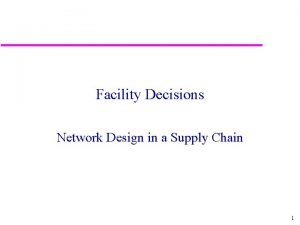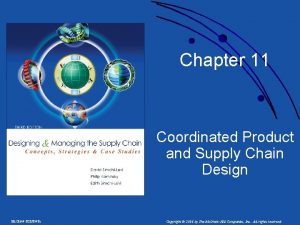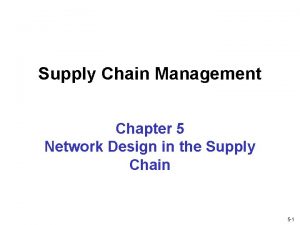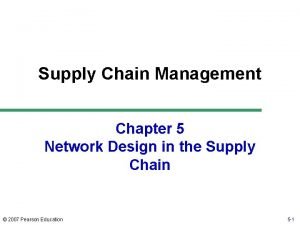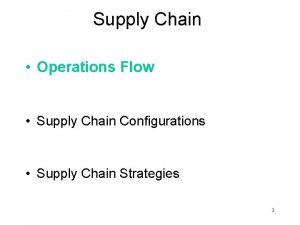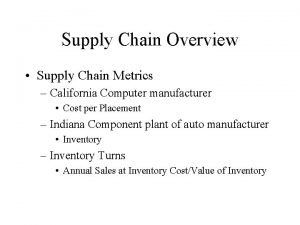Wholesale Electricity Market Market design The supply chain
















- Slides: 16

Wholesale Electricity Market

Market design • The supply chain of electricity can be divided in three industries: : production, transmission and distribution • Industry separation lead to the design of "organized" electricity markets that are based on bilateral or centralized contracts • In the electricity markets (Power Exchange), sales are manage by a third party: the Market Operator • The MO organizes demand supply in order to define the equilibrium price • In the market of bilateral contracts, bargaining is continuous and not at regular intervals as in the organized market

Market design • Markets with bilateral contracts make it more difficult the process of electricity transmission, especially in presence of transmission capacity constraints • Actually, the models adopted in most advance countries are mixed with both the presence of a power exchange and bilateral contracts markets • In these models, the role of the MO is not only to manage the market mechanism but also to ensure an efficient and dispatching services • The second task can be achieved through two other markets: the market of reserve energy and the market for the real time balancing

Market rules • The main aim of the regulator is to design a regulatory framework able to guarantee competitive markets • The electricity markets, however, are by their nature incomplete and imperfect (ie non-competitive). 1. They are imperfect because oligopolistic (economies of scale and barriers to entry) 2. They are incomplete because the specific features of the traded commodity makes it difficult both the accumulation and the distribution process

Market rules • Market design implies the definition of a system of integrated markets ü ü ü Spot market Futures market Market with financial derivatives • The main aspect of the market design is the definition of the auction mechanism

The spot market • Traditionally spot markets involve an immediate delivery of the goods exchanged • In the electricity sector the process of generation implies that there is not a real spot market but rather a day-ahead market • The only real spot market is the market for the real time balancing • In the Day-ahead market the good traded is standardized and defined by fixed time intervals (typically hours) • Bids are aggregated for each hour according to an increasing price ranking defining the so called merit order • Demand is aggregate according to decreasing price ranking • Finally, the intersection of the two curves produces the equilibrium price and quantity in the market

The equilibrium price • The point of intersection between the aggregate supply and demand is called the System Marginal Price (SMP) Supply P S P* Demand D Mw Equilibrium price

The equilibrium price • The SMP is a uniform price for all producers • Other markets can imply a no unique price. In the pay-as-bid model, each seller receives the value of its bid offered before the end of the auction (auction price discrimination) • The mechanism of price discrimination could reduce the price volatility but could increase the average price. • The SMP favors the entry of new firms improving the competitiveness of the system. However, this mechanism can also facilitate the exercise of market power (especially if stronger operators can foresee in an efficient way the equilibrium price) • In summary, to promote consumer welfare auction with price discrimination mechanism are preferred. Uniform-price auctions are more effective in the promotion of market competition

Trasmission contraints • Quando la domanda di trasporto dell’elettricità supera la capacità disponibile della rete si manifestano i fenomeni di congestione nella trasmissione. When the demand for electricity exceeds the network transmission capacity there is a problem of congestion • In the presence of congestion, market operator can decide to split the markets in order to define zonal prices and ensure the sustainability of the system in real time

Market separation • Assuming two different areas linked by a unique transmission line Demand P Da+Db Supply P* Sa+Sb Mw Equilibrium price without congestion

Equilibrium price without congestion • In the zone-A, at the equilibrium price, the supply is equal to in Qa=W, while in zone-B is equal to Qb=V • The level of electricity produced in the zone-A allows to satisfy "domestic demand" and to export the amount X to zone-B Db Da P Sb Da X Sa P* X Mw W V Equilibrium price without congestion

Equilibrium price with congestion • • Assuming there is a transmission constraint equal to Y Now, zone-A can export only a level equal to Y (less than X) The production in the zone-A will be equal to QFa with the price Pa In the zone-B, the presence of the transmission constraint causes a reduction in imports and the activation of local generators that produce at higher costs Db Da P Y Y Sb Db Da X Sa Pb Pa X Mw QFa QFb Equilibrium price in presence of congestion

Equilibrium price with congestion • The equilibrium prices obtained in the two markets are the bids offered by marginal suppliers in the two zones. It is possible to identify the "revenue" of congestion as (Pa+ Pb)Y • Total profits with congestion must be equal to the sum of supplier profits and the "congestion revenue": Pa. Da+Pb. Db= : Pa. QFa+Pb. QFb+(Pa+ Pb)Y

Congestion • In the wholesale electricity market, the market operator has a monitoring function to verify if the merit order obtained in the day-ahead market is compatible with the transmission network capacity • As we have seen if the capacity is insufficient, we have a congestion • To manage congestion, the MO has two instruments: ü The redefinition of the merit order ü The market separation

Congestion • In the first case, the MO can ask to market participants to modify their offer in areas where congestion occurs or call the plants more "expensive" (initially excluded by the merit order) in the same areas where congestion is realized • The market separation (market splitting) leads to separate the market into submarkets and to determine the prices in different nodes • Prices in areas where congestion occurs will be higher than those obtained in the rest of the market

XVIII International Tor Vergata Conference on Money, Banking, and Finance 2 -4 December 2009 Elementary zones aggregation Zones % Sa 24. 18% N-Cn 2. 83% Si 18. 95% ITA 2. 54% N 12. 15% Cn-Cs-S-Si-Sa 1. 99% N-Cn-Cs-S (Peninsula) 11. 33% Cs-S-Si 1. 97% Cn-Cs-S 6. 74% Cs-S 1. 85% N-Cn-Cs-S-Si 5. 90% Cn 0. 37% Cn-Cs-S-Si 3. 93% Cs-S-Sa 0. 15% N-Cn-Cs-S-Sa 3. 30% Cs-S-Si-Sa 0. 15% Cn-Cs-S-Sa 1. 35% Others 0. 03% Relative frequency of each realized aggregation zone Period: April – December 2004; Hourly clusters. # 18, 885
 Matching supply with demand
Matching supply with demand Static electricity and current electricity
Static electricity and current electricity Current electricity gif
Current electricity gif Electricity and magnetism vocabulary
Electricity and magnetism vocabulary Value chain and supply chain difference
Value chain and supply chain difference Sequence of food chain
Sequence of food chain Framework for network design decisions
Framework for network design decisions Network design decisions
Network design decisions Supply chain network design decisions
Supply chain network design decisions Coordinated product and supply chain design
Coordinated product and supply chain design Supply chain management network design
Supply chain management network design Facility role in network design
Facility role in network design Wholesale market near me
Wholesale market near me Western wholesale market
Western wholesale market Wa electricity market
Wa electricity market Market leader follower challenger nicher
Market leader follower challenger nicher Segmentation levels
Segmentation levels







